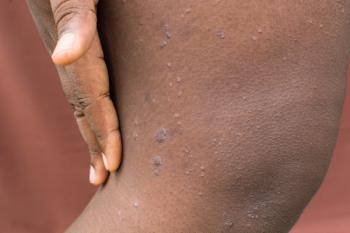
Hair Metabolome May Help Diagnose Pulmonary Fibrosis
The proof-of-concept study also identified key metabolites that correlated with pulmonary fibrosis diagnosis and disease progression.
Doctors may be able to diagnose and measure the progression of
Fibrotic
The researchers collected hair samples from 56 patients with pulmonary fibrosis and 14 patients without, then used advanced lab techniques to extract and analyze metabolites. They then used machine learning to create classification models, carefully fine-tuning these models with various validation and testing methods. This approach aimed to distinguish between patients with and without pulmonary fibrosis and to identify those with stable vs progressing disease.
The study achieved promising results in predicting whether patients had pulmonary fibrosis when measuring the area under the receiver operating characteristic (AUROC), with an AUROCTRAIN of 0.888 (0.794-0.982) and an AUROCTEST of 0.908. It also accurately predicted stable vs progressing disease, with an AUROCTRAIN of 0.833 (0.784-0.882) and an AUROCTEST of 0.799. For reference, an area under the curve (AUC) of 0.5 suggests no discrimination, while an AUC closer to 0 is poor, an AUC between 0.7 and 0.8 is acceptable, an AUC between 0.8 and 0.9 is excellent, and an AUC more than 0.9 is outstanding.2
The researchers also identified key metabolites for diagnosis, including:
- Ornithine
- 4-(methylnitrosamino)-1–3-pyridyl-N-oxide-1-butanol
- Thr-Phe
- Desthiobiotin
- Proline
Meanwhile, key metabolites associated with disease progression included:
- Azelaic acid
- Thr-Phe
- Ala-Tyr
- Indoleacetyl glutamic acid
- Cytidine
“Hair is composed mainly of fibrous proteins, melanin, water, lipids, and minerals and provides a highly stable structure that retains endogenous metabolites for long term, providing a useful biological matrix in forensics analyses,” the researchers said. “Since hair has been shown to reflect the serum metabolome over time, it is unsurprising that some amino acids detected in this study are consistent with metabolites previously implicated in ILD [interstitial lung disease].”
The study's limitations include a small sample size and data from a single clinic. Although the findings suggest that hair metabolome analysis can predict pulmonary fibrosis and identify potential biomarkers, the approach mainly reveals correlations without establishing causation. Due to these limitations, the researchers noted that this study was exploratory and serves to generate hypotheses for future studies.
“The use of machine learning to predict the importance of biomarkers and their role in pulmonary fibrosis clinical outcomes is still a relatively unexplored field,” the researchers added. “This proof-of-concept study reveals a novel approach for detection of molecular signatures characteristic of pulmonary fibrosis.”
The researchers plan to carry out larger studies to confirm their findings. In the future, they hope that standardizing these new metabolite markers from hair samples could help diagnose and assess the risk of pulmonary fibrosis more quickly and accurately, leading to better, earlier, and more targeted treatments.
Reference
- Miller HA, Suliman S, Frieboes HB. Pulmonary fibrosis diagnosis and disease progression detected via hair metabolome analysis. Lung. Published online June 11, 2024. doi:10.1007/s00408-024-00712-3
- Hosmer DW, Lemeshow S. Applied Logistic Regression, 2nd Ed. John Wiley and Sons; 2000. Pp. 160-164
Newsletter
Stay ahead of policy, cost, and value—subscribe to AJMC for expert insights at the intersection of clinical care and health economics.








































